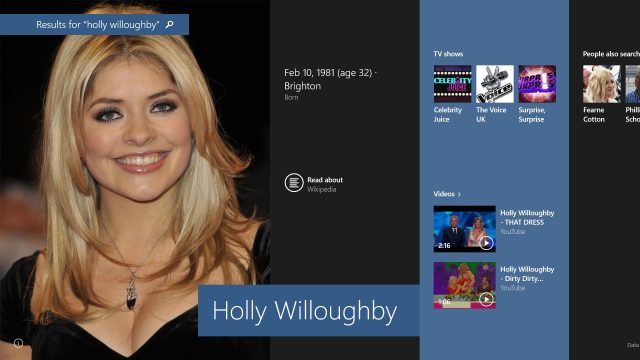
Microsoft's Bing search engine takes center stage in Windows 8.1. Windows 8 already shipped with a bunch of apps—things like News, Weather, and Sports—developed by the Bing team, using Bing services, but that's all they were: apps that ran on the operating system, rather than integral features of the operating system.
In Windows 8.1, Bing has a deeper integration. Some of this is immediately visible; other parts are more subtle. Together, they suggest that Microsoft is not the company it once was. It's a better one.
Bing now powers Windows 8.1's search. Head into the search charm (or invoke it directly, with Win-S, for Search), type a search term, and hit return, and you'll be taken to a full-screen search app. This will include relevant local hits (files, apps, and settings), but it goes a lot further than that, thanks to data taken from Bing.
Pretty much any search term will result in Web search results. This is the most obvious thing for Bing to do, of course, since at its heart it is a search engine; however, they're not the only thing that you can find.
Bing doesn't just index Web content. It tries to extract structured, meaningful information from Web pages, using this information to construct entities. Consider, for example, the search for Holly Willoughby I took a picture of here. Bing knows that "Holly Willoughby" is not merely a sequence of letters; it knows that it's the name of a particular person with an age, a place of birth, a picture, and a Wikipedia page. It knows that she's been in a number of specific TV shows, that there are videos that feature her, and that people who search for her often also search for her various co-presenters on the shows she's been in.

The search tool shows Web results alongside the structured entities. It has been reported that it will eventually show advertising along with these results, which will be an odd juxtaposition. On the one hand, it's normal for Web search results to show ads, and in principle, those ads can even be useful (especially for things like searches for products). On the other hand, I expect lots of people will argue that ads have no place in a commercial operating system.
These structured results (called "Search heroes" by Microsoft) can also link into applications. So the Holly Willoughby Wikipedia link doesn't take you to her Wikipedia entry on the Web; it takes you to the corresponding place in the Wikipedia app. If you don't have the app, you're prompted to install it.
This deep linking is currently at Microsoft's discretion. Bing knows which apps are popular and well-regarded, and will link to them when appropriate. There isn't, however, any way for an application to declare "I know about Movie entities," say, and have that show up in relevant searches automatically. This is different from Windows Phone, which does let apps declare that they understand certain kinds of information, ensuring that they get wired up to search results.
The search results are the most visible part of Bing's integration, but not the only part. As part of its modelling and analysis, Bing builds language models. These are then used to inform the autocomplete corrections that the Windows 8.1 soft keyboard uses. Bing knows the hot topics of the day and the names and places that people are talking and typing about, and it can adjust its language model data accordingly. Windows 8.1 then downloads this data daily. In this way, the keyboard behavior can change, albeit subtly, to stay current.
Microsoft isn't the only company to build this kind of search-driven, data-driven capability into its operating system. Windows 8.1 uses Bing in a reactive, user-directed way. Google has arguably gone a step further with Google Now. Google Now pulls data from, for example, appointments in your calendar to proactively show structured information that it assumes will be useful: weather, driving directions, that kind of thing.
Microsoft isn't doing that proactive searching just yet. Members of the Bing team tell us that the difficulty for this kind of system is proper handling of mistakes. If the system generates mistakes—for example, giving you useless driving directions explaining how to drive home, even though you've flown across the country for a week to go to a conference—then users will lose confidence in it and stop using it.
Both ensuring that those mistakes are rare and giving users a good way to fix mistakes remain challenging. To continue the example, users need to be able to tell the system, "I don't care about that set of driving directions" while still not disabling the ability to show directions in general.
Google building search-driven features into Android isn't surprising. It's what Google does. Microsoft building Bing-driven features into Windows shouldn't be surprising. But it is.
Microsoft has traditionally been a company that made internal divisions painfully visible to outsiders. In fact, this aspect of the company has become an object of ridicule: It's joked that the company's org chart has a bunch of divisions pointing guns at each other, such is their hostility to one another.
For example, the Office team pointedly refused to do anything to enable the core Office products (Word, Excel, PowerPoint, and Outlook), or do anything to support the Windows team's decade-long attempt to produce a tablet operating system. Even the very latest Office 2013 makes only minimal concessions to tablet usage.
A comment that an ex-employee posted on Ars in the wake of departure of Steven Sinofsky, former President of the Windows Division tells a similar story: good, popular products and teams were destroyed if they weren't serving the Windows division.
The Bing integration in Windows 8.1 is a sign that the company is working to put those days behind it. The Bing group's knowledge and expertise—collection and processing of vast amounts of data, extraction of semantic meaning—is being used to make another group's product—Windows—better. This is the approach Microsoft should have had all along: build the best products, regardless of which division or team was responsible for a particular piece of technology.
When Sinofsky left last November, there were widespread rumors that he'd been pushed out precisely because of difficulties in achieving this kind of collaboration. CEO Steve Ballmer wants Microsoft to be more collaborative as part of its transition to a "Devices and Services" company, and the rumors claim that Sinofsky was seen as an impediment to this.
There's some irony in that; Sinofsky himself is credited with saying "Don't ship the org chart;" that is, don't make internal divisions apparent in the shipping product, while being blamed for an apparent inability to overcome those same internal divisions.
Microsoft is believed to be planning an internal reorganization to further the "Devices and Services" ambitions. In the old Microsoft, this reorganization would be significant for employees and customers alike, as the structure of the organization would directly impact the design of its products.
But Windows 8.1 shows that it might not be such a big deal for anyone outside the company after all. The Bing integration in Windows 8.1 gives a hint that the collaboration and company-wide agendas that Ballmer wants to promote are already starting to materialize and are already yielding better products. The reorganization might formalize a new Microsoft that pulls together as one, but signs are that the hard work has already begun.
reader comments
203